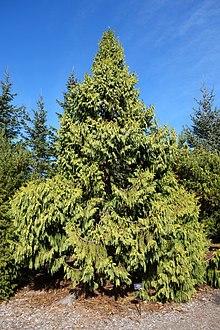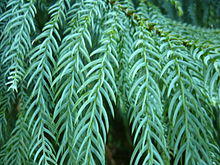| Taiwania | |
|---|---|
 | |
| Scientific classification | |
| Kingdom: | Plantae |
| Clade: | Tracheophytes |
| Division: | Pinophyta |
| Class: | Pinopsida |
| Order: | Pinales |
| Family: | Cupressaceae |
| Subfamily: | Taiwanioideae |
| Genus: | Taiwania Hayata |
| Species: | T. cryptomerioides |
| Binomial name | |
| Taiwania cryptomerioides Hayata | |
| Synonyms[2] | |
| |
Taiwania, with the single living species Taiwania cryptomerioides, is a large coniferous tree in the cypress family Cupressaceae.
Range
The genus was formerly placed in the segregate family Taxodiaceae, it is now included in the monotypic subfamily Taiwanioideae of the family Cupressaceae. It is native to eastern Asia, growing in the mountains of central Taiwan, and locally in southwest China (Guizhou, Hubei, Sichuan, Yunnan, Tibet) and adjoining Myanmar, and northern Vietnam.[2][3] It is endangered by illegal logging for its valuable wood in many areas. It is very likely that the range was more extensive in the past before extensive felling for the wood.[1] The populations in mainland Asia were treated as a distinct species Taiwania flousiana by some botanists, but the cited differences between these and the Taiwanese population are not consistent when a number of specimens from each area are compared.
Morphology
It is one of the largest tree species in Asia, reported to heights of up to 90 m (300 ft) tall and with a trunk up to 4 m (13 ft) diameter above buttressed base.[4] The leaves are needle-like or awl-like and 8–15 mm (0.31–0.59 in) long on young trees up to about 100 years old, then gradually becoming more scale-like, 3–7 mm (0.12–0.28 in) long, on mature trees. The cones are small, 15–25 mm (0.59–0.98 in) long, with about 15–30 thin, fragile scales, each scale with two seeds.
History
The genus is named after the island of Taiwan, from where it first became known to the botanical community in 1910.
The wood is soft, but durable and attractively spicy scented, and was in very high demand in the past, particularly for temple building and coffins. The rarity of the tree and its slow growth in plantations means legal supplies are now very scarce; the species has legal protection in China and Taiwan.
Taiwania is also a journal that is published by National Taiwan University.
References
- ^ a b Thomas, P. & Farjon, A. (2011). "Taiwania cryptomerioides". The IUCN Red List of Threatened Species. IUCN. 2011: e.T31255A9620141. doi:10.2305/IUCN.UK.2011-2.RLTS.T31255A9620141.en. Retrieved 15 January 2018.
- ^ a b "Taiwania". World Checklist of Selected Plant Families (WCSP). Royal Botanic Gardens, Kew.
- ^ Fu, Liguo; Yu, Yong-fu; Mill, Robert R. "Taiwania cryptomerioides". Flora of China. 4 – via eFloras.org, Missouri Botanical Garden, St. Louis, MO & Harvard University Herbaria, Cambridge, MA.
- ^ Farjon, A. (2005). Monograph of Cupressaceae and Sciadopitys. Royal Botanic Gardens, Kew. ISBN 1-84246-068-4

_(20401224415).jpg)
